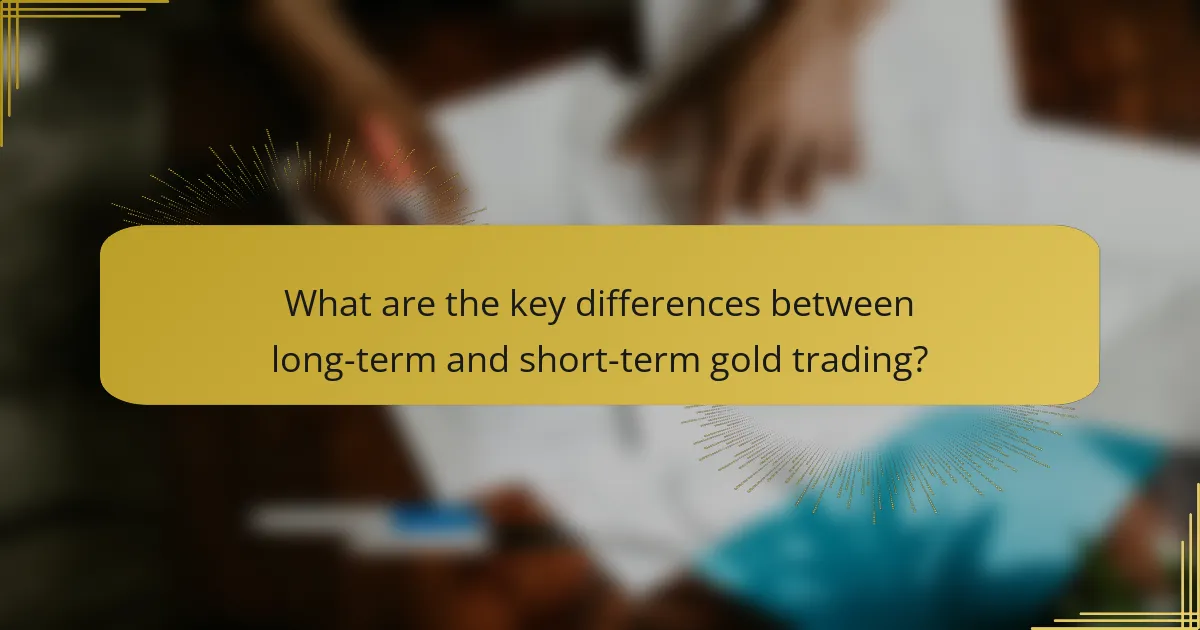The article focuses on the comparison between long-term and short-term gold trading strategies, examining their respective approaches, risks, and profit potential. Long-term gold trading emphasizes holding investments for years, utilizing strategies like buy-and-hold, dollar-cost averaging, and trend following, which often lead to lower transaction costs and better returns during economic downturns. In contrast, short-term gold trading involves strategies such as day trading, swing trading, and scalping, relying on technical analysis to capitalize on quick price movements, albeit with higher transaction costs and risks. Additionally, the article highlights the importance of market timing in maximizing profit margins, illustrating how accurate timing can significantly impact trading outcomes.

What are the key differences between long-term and short-term gold trading?
Long-term gold trading focuses on holding gold investments for extended periods, typically years. Short-term gold trading involves buying and selling gold within shorter time frames, often days or weeks. Long-term traders aim for gradual price appreciation and may ignore short-term market fluctuations. They often analyze fundamental factors like economic indicators and geopolitical stability. Short-term traders rely on technical analysis, price patterns, and market trends to capitalize on quick price movements. Long-term strategies generally involve lower transaction costs due to fewer trades. In contrast, short-term trading incurs higher costs from frequent transactions. Historical data shows that long-term gold investments have provided better returns during economic downturns. Short-term trading can yield quick profits but also carries higher risks due to market volatility.
How do investment goals influence trading strategies in gold?
Investment goals significantly influence trading strategies in gold. Long-term investors typically adopt a buy-and-hold strategy. They focus on gold’s potential for appreciation over time. This approach aligns with goals of wealth preservation and inflation hedging.
Conversely, short-term traders often employ strategies like day trading or swing trading. They aim to capitalize on market fluctuations. Their goals include quick profits and leveraging volatility.
Market conditions also affect these strategies. For example, during economic uncertainty, long-term investors may increase their gold holdings. In contrast, short-term traders might react quickly to price movements.
Ultimately, the alignment of investment goals with trading strategies shapes the approach to gold trading. This connection determines whether the focus is on long-term stability or short-term gains.
What are the typical objectives of long-term gold investors?
The typical objectives of long-term gold investors include wealth preservation, inflation hedge, and portfolio diversification. Long-term investors seek to protect their capital against economic downturns. Gold has historically maintained its value during inflationary periods. Many investors allocate a portion of their portfolio to gold to reduce overall risk. This strategy helps balance potential losses from other asset classes. Additionally, long-term gold investors often aim for capital appreciation over time. Historical data shows that gold prices tend to rise during geopolitical instability. These objectives align with the broader goal of achieving financial security and stability.
How do short-term traders define success in gold trading?
Short-term traders define success in gold trading primarily by achieving consistent profits over a brief period. This involves executing trades that capitalize on small price movements. Successful short-term traders often set specific profit targets and risk management strategies. They typically aim for a high win rate, often exceeding 50%. Performance metrics, such as return on investment (ROI), are crucial for measuring success. Additionally, maintaining a disciplined trading approach is essential. Many traders utilize technical analysis to identify entry and exit points. Short-term success is often reflected in the ability to adapt to market volatility quickly.
What market conditions favor long-term versus short-term trading?
Long-term trading is favored in stable market conditions with low volatility. These conditions allow traders to hold positions for extended periods without significant price fluctuations. Economic indicators such as consistent GDP growth and low unemployment support long-term investments.
Short-term trading thrives in volatile markets with rapid price movements. Traders capitalize on quick fluctuations, often driven by news events or market sentiment. High trading volumes and liquidity are essential for short-term strategies.
In summary, stable environments favor long-term strategies, while volatility benefits short-term approaches.
How do economic indicators impact long-term gold trading strategies?
Economic indicators significantly impact long-term gold trading strategies. These indicators include inflation rates, interest rates, and unemployment figures. When inflation rises, investors often turn to gold as a hedge against currency devaluation. This increased demand can drive gold prices higher, influencing long-term trading decisions. Conversely, higher interest rates typically strengthen the dollar. A stronger dollar can decrease gold’s appeal, leading traders to adjust their strategies accordingly. Historical data shows that during economic downturns, gold prices tend to rise as investors seek safety. Therefore, tracking these indicators is crucial for formulating effective long-term gold trading strategies.
What technical signals are most relevant for short-term gold trading?
The most relevant technical signals for short-term gold trading include moving averages, RSI, and MACD. Moving averages help identify trends by smoothing price data over specific periods. The Relative Strength Index (RSI) indicates overbought or oversold conditions, guiding entry and exit points. The Moving Average Convergence Divergence (MACD) signal line crossover provides buy or sell signals based on momentum shifts. These indicators are widely used by traders to make informed decisions in volatile markets. Historical data shows that combining these signals can enhance trading accuracy and profitability.

What strategies are commonly used in long-term gold trading?
Long-term gold trading strategies typically include buy-and-hold, dollar-cost averaging, and trend following. Buy-and-hold involves purchasing gold and maintaining ownership over an extended period. This strategy capitalizes on gold’s historical price appreciation. Dollar-cost averaging entails investing a fixed amount regularly, reducing the impact of market volatility. Trend following focuses on analyzing market trends to make informed buying decisions. Research indicates that gold has provided an average annual return of 10.6% over the last 50 years, supporting these strategies.
How can investors effectively build a long-term gold portfolio?
Investors can effectively build a long-term gold portfolio by diversifying their investments across various forms of gold. This includes physical gold, gold ETFs, and gold mining stocks. Diversification helps mitigate risks associated with market fluctuations.
Investors should allocate a percentage of their portfolio to gold based on their risk tolerance and investment goals. A common recommendation is 5-10% of the total portfolio. This allocation has historically provided a hedge against inflation and currency devaluation.
Regularly reviewing and rebalancing the portfolio is essential to maintain the desired gold allocation. This practice ensures that the portfolio aligns with changing market conditions.
Investors should also consider the long-term trends in gold prices. Historical data shows that gold has appreciated over the long term, especially during economic downturns.
Staying informed about geopolitical events and economic indicators can help investors make timely decisions regarding their gold investments. This knowledge allows for better market timing, enhancing potential returns.
Overall, a well-structured approach combining diversification, regular monitoring, and informed decision-making can lead to an effective long-term gold portfolio.
What factors should be considered when selecting gold assets for long-term investment?
When selecting gold assets for long-term investment, consider market trends, economic stability, and geopolitical factors. Gold prices are influenced by supply and demand dynamics. Historical performance indicates that gold often retains value during economic downturns. Evaluate purity levels in gold assets, as higher purity typically correlates with better long-term value. Additionally, consider storage costs and security for physical gold. Assess the liquidity of the gold assets, ensuring they can be easily converted to cash if needed. Lastly, review the reputation of sellers or funds involved in gold investments to ensure reliability and trustworthiness.
How do diversification and risk management play a role in long-term strategies?
Diversification and risk management are essential components of long-term strategies in gold trading. Diversification involves spreading investments across various assets to reduce exposure to any single risk. This approach minimizes potential losses from market volatility, as not all assets will move in the same direction at the same time.
Risk management, on the other hand, focuses on identifying, assessing, and mitigating risks associated with investments. Effective risk management strategies include setting stop-loss orders and regularly reviewing investment portfolios. According to a study by the CFA Institute, diversified portfolios tend to outperform non-diversified ones over extended periods due to reduced risk and enhanced returns.
Together, diversification and risk management create a balanced investment strategy that supports sustained growth in long-term gold trading.
What are the advantages of long-term trading in gold?
Long-term trading in gold offers several advantages. It allows investors to benefit from gold’s historical price appreciation. Over the last two decades, gold prices have increased significantly, often serving as a hedge against inflation. Long-term trading reduces transaction costs associated with frequent buying and selling. It also minimizes the impact of short-term market volatility. Investors can take advantage of compounding returns over time. Furthermore, holding gold long-term can provide a sense of security during economic downturns. This strategy aligns with the historical trend of gold as a stable asset.
How does compounding affect returns in long-term gold investments?
Compounding significantly enhances returns in long-term gold investments. Over time, the gains from gold investments can be reinvested to generate additional returns. This effect is amplified due to the nature of exponential growth. For example, if an investor holds gold that appreciates at an average annual rate of 5%, the returns in the second year are calculated on the initial investment plus the returns from the first year. Historical data shows that gold has appreciated by approximately 10% annually over the past 50 years, illustrating the power of compounding. As the investment period increases, the impact of compounding becomes more pronounced. This leads to a substantial increase in the total value of the investment over time. Thus, compounding is a crucial factor in maximizing returns from long-term gold investments.
What tax benefits might long-term gold investors experience?
Long-term gold investors may benefit from lower capital gains tax rates. In the United States, assets held for more than one year are typically taxed at a lower rate than short-term investments. The long-term capital gains tax rate can be 0%, 15%, or 20%, depending on the investor’s income level. This contrasts with short-term capital gains, which are taxed as ordinary income. Additionally, gold investments can be held in tax-advantaged accounts like IRAs, allowing for tax deferral on gains until withdrawal. These factors make long-term gold investment potentially more tax-efficient compared to short-term trading.

What strategies are commonly used in short-term gold trading?
Common strategies in short-term gold trading include day trading, swing trading, and scalping. Day trading involves buying and selling gold within the same trading day. Traders capitalize on small price fluctuations. Swing trading holds gold positions for several days to capture short-term market moves. Scalping focuses on making quick trades for small profits, often executed within minutes. Technical analysis is crucial for all these strategies. Traders utilize charts and indicators to identify entry and exit points. Market news and economic data also influence trading decisions. These strategies aim to maximize profit while minimizing risk in volatile markets.
What are the best practices for executing short-term gold trades?
To execute short-term gold trades effectively, traders should focus on market analysis and timing. Utilizing technical analysis helps identify price trends and potential entry and exit points. Setting clear profit targets and stop-loss orders minimizes risks. Staying updated on economic indicators and geopolitical events influences gold prices. Using a reliable trading platform ensures quick execution of trades. Monitoring market sentiment through news and social media provides additional insights. Diversifying trading strategies can enhance potential returns. Finally, maintaining discipline and avoiding emotional trading decisions is crucial for consistent success.
How can traders utilize technical analysis for short-term gold trading?
Traders can utilize technical analysis for short-term gold trading by analyzing price charts and identifying patterns. They use indicators such as moving averages and Relative Strength Index (RSI) to gauge market trends. Chart patterns like head and shoulders or triangles can signal potential price movements. Traders often look for support and resistance levels to make entry and exit decisions. Volume analysis is also crucial, as it confirms price movements. Backtesting strategies on historical data enhances decision-making accuracy. For instance, studies show that technical analysis can improve trading outcomes by providing timely signals.
What role does market sentiment play in short-term trading decisions?
Market sentiment significantly influences short-term trading decisions. It reflects the overall attitude of investors toward a particular market or asset. Traders often rely on sentiment indicators, such as news trends and social media analysis, to gauge market mood. Positive sentiment can lead to increased buying activity, while negative sentiment may trigger selling. Research shows that sentiment can predict price movements in the short term. For instance, a study by Baker and Wurgler found that investor sentiment can affect stock prices, indicating its importance in trading strategies. Understanding market sentiment helps traders make informed decisions quickly.
What are the risks associated with short-term gold trading?
Short-term gold trading involves significant risks. Market volatility can lead to rapid price changes. Traders may face losses due to unexpected geopolitical events. High transaction costs can erode profits from quick trades. Psychological factors may influence decision-making, leading to impulsive actions. Additionally, leverage can amplify both gains and losses. According to a report by the World Gold Council, short-term fluctuations can be unpredictable. Therefore, traders should be aware of these inherent risks before engaging in short-term strategies.
How can volatility impact short-term trading outcomes?
Volatility can significantly impact short-term trading outcomes by increasing the potential for rapid price changes. High volatility can lead to larger price swings within a short timeframe. This creates opportunities for traders to capitalize on quick movements. However, it also increases the risk of substantial losses. Traders must be adept at managing their risk exposure during volatile periods. Historical data shows that assets with higher volatility can yield greater returns but also come with higher risk. For example, during economic announcements, gold prices can fluctuate dramatically, affecting short-term trading strategies. Thus, understanding volatility is crucial for making informed trading decisions.
What are common pitfalls to avoid in short-term gold trading?
Common pitfalls to avoid in short-term gold trading include emotional trading, lack of research, and ignoring market trends. Emotional trading can lead to impulsive decisions that result in losses. Lack of research may cause traders to miss critical information affecting gold prices. Ignoring market trends can result in poor timing for buying or selling. Additionally, over-leveraging can amplify losses, making it crucial to manage risk effectively. Lastly, neglecting to set stop-loss orders can lead to significant financial damage. These pitfalls can be detrimental to a trader’s success in the volatile gold market.

How can market timing affect profit margins in gold trading?
Market timing significantly impacts profit margins in gold trading. Traders who buy gold at lower prices and sell at higher prices maximize their profit margins. Accurate market timing allows traders to capitalize on price fluctuations. Historical data shows that gold prices can vary considerably over short periods. For example, in 2020, gold prices surged by over 25% due to economic uncertainty. Conversely, poor timing can lead to buying at peak prices, resulting in reduced margins. Effective market timing strategies often involve analyzing market trends and economic indicators. This approach helps traders make informed decisions that enhance profitability.
What indicators should traders watch for optimal market timing?
Traders should watch for moving averages, relative strength index (RSI), and volume indicators for optimal market timing. Moving averages help identify trends by smoothing price data over a specific period. The 50-day and 200-day moving averages are particularly significant. The relative strength index indicates overbought or oversold conditions, signaling potential reversals. A reading above 70 suggests overbought conditions, while below 30 indicates oversold conditions. Volume indicators confirm the strength of a price movement. High volume during a price increase indicates strong buying interest. Conversely, low volume may suggest a lack of conviction in the price movement. These indicators collectively provide a comprehensive view of market conditions.
How do geopolitical events influence gold market timing?
Geopolitical events significantly influence gold market timing by affecting investor sentiment and demand for safe-haven assets. When geopolitical tensions arise, such as conflicts or political instability, investors often flock to gold as a protective measure. This behavior typically leads to increased gold prices and volatility in the market. For example, during the 2008 financial crisis, gold prices surged as uncertainty prevailed. Historical data shows that gold often spikes in response to major geopolitical events, such as wars or significant elections. This pattern indicates a clear correlation between geopolitical developments and gold market dynamics.
What seasonal trends should traders consider when timing gold trades?
Traders should consider the seasonal trends of gold demand, which typically peak during certain times of the year. Historically, gold prices rise before major Indian festivals, such as Diwali, due to increased jewelry purchases. Additionally, the wedding season in India, which spans from October to December, also boosts gold demand.
In Western markets, gold often sees price increases during economic uncertainty or geopolitical tensions, which can occur at various times throughout the year. Moreover, the demand for gold tends to increase during the Chinese New Year, as consumers purchase gold as gifts.
Statistical data shows that gold prices have historically experienced upward trends during these key periods, making them critical for traders to consider. Understanding these seasonal patterns can help traders optimize their timing for entering and exiting gold trades.
What strategies can enhance profit margins in gold trading?
To enhance profit margins in gold trading, implement strategies such as market analysis, diversification, and risk management. Conducting thorough market analysis helps identify trends and price movements. Utilizing technical and fundamental analysis can provide insights into optimal entry and exit points. Diversification across different gold assets can mitigate risks and enhance returns. Employing risk management techniques, such as setting stop-loss orders, protects against significant losses. Additionally, leveraging trading platforms with low fees can increase overall profitability. Historical data shows that traders who combine these strategies often achieve higher profit margins. For instance, a study by the World Gold Council indicates that informed trading decisions can lead to a 20% increase in profit margins over time.
How does leverage affect profit potential in gold trading?
Leverage increases profit potential in gold trading by allowing traders to control larger positions with a smaller amount of capital. For example, a leverage ratio of 10:1 means that a trader can control $10,000 worth of gold with only $1,000. This magnifies both potential gains and losses. If the price of gold increases by 1%, the trader’s profit would be $100 instead of $10 without leverage. However, the risk is also amplified. A 1% decline in gold’s price could lead to a $100 loss, which is significant relative to the initial investment. Therefore, while leverage can enhance profit potential, it also increases the risk of substantial losses.
What are the benefits of using stop-loss orders in gold trading?
Stop-loss orders in gold trading help manage risk effectively. They automatically sell gold when prices reach a specified level. This limits potential losses for traders. By setting a stop-loss, traders can protect their capital. It allows for emotional detachment from trading decisions. Traders can focus on strategy rather than market fluctuations. Research indicates that using stop-loss orders can enhance trading performance. A study by the CFA Institute found that disciplined risk management improves overall returns.
What practical tips can help traders succeed in both long-term and short-term gold trading?
Traders can succeed in both long-term and short-term gold trading by employing several practical tips. First, they should conduct thorough market research. Understanding market trends and historical data is crucial. Secondly, setting clear goals is essential. Traders need to define their risk tolerance and profit expectations. Thirdly, utilizing stop-loss orders can help minimize losses. This strategy protects investments in volatile markets. Fourthly, diversifying portfolios is important. Including various assets can reduce risks associated with gold trading. Lastly, staying updated on economic news is vital. Economic indicators often influence gold prices significantly. Following these tips can enhance traders’ chances of success in both trading strategies.
The main entity of the article is gold trading, specifically comparing long-term and short-term strategies. The article examines the key differences between these trading approaches, including investment goals, market conditions, and the impact of economic indicators. It outlines typical objectives for long-term investors, such as wealth preservation and inflation hedging, while also detailing how short-term traders define success through quick profits and technical analysis. Additionally, the article highlights strategies, market timing, and risk management techniques relevant to both trading styles, providing insights into optimizing profit margins and the potential benefits of using stop-loss orders.